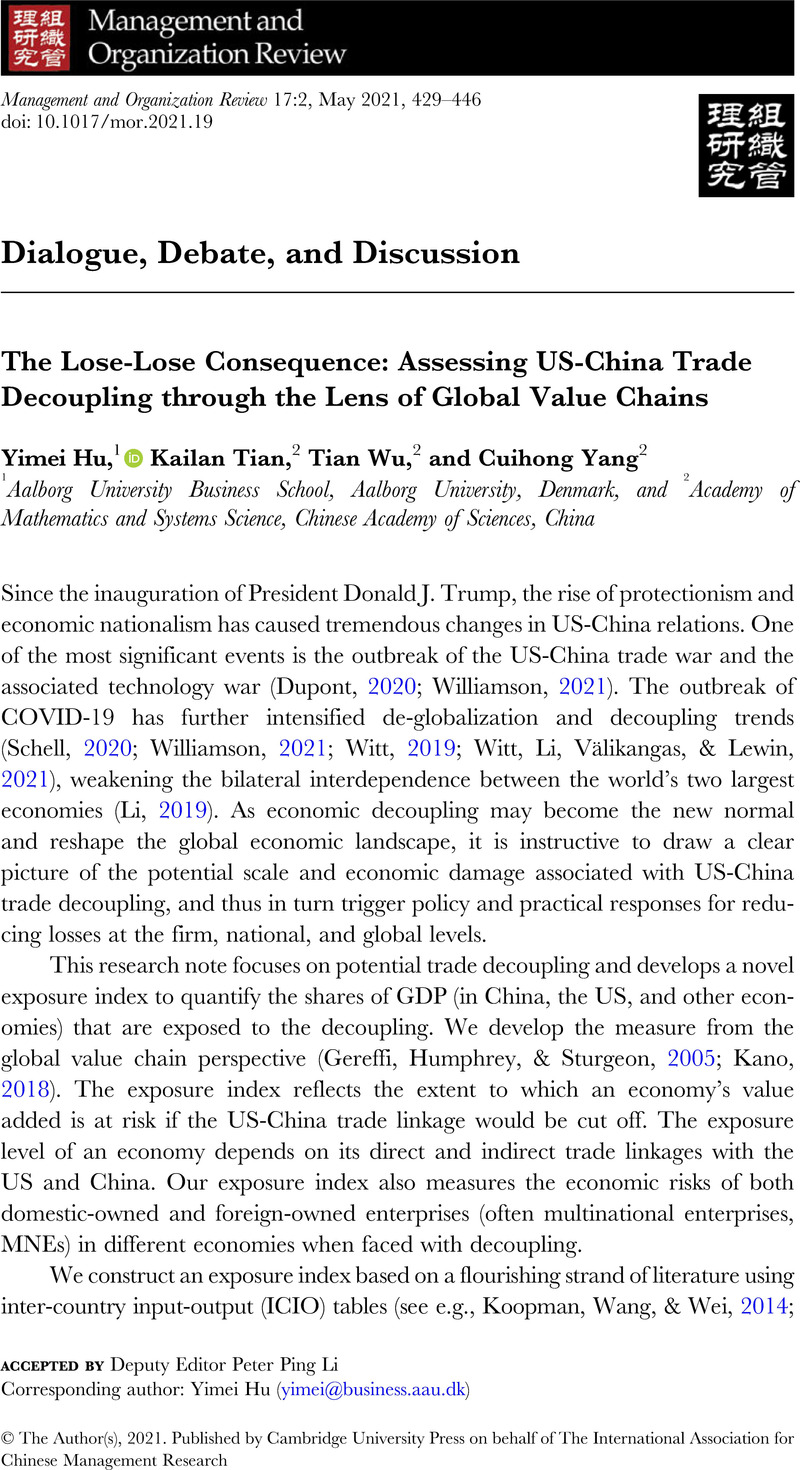Crossref Citations
This article has been cited by the following publications. This list is generated based on data provided by Crossref.
Wang, Liang
and
Xie, Zaiyang
2021.
An Outcome of Decoupling and De-globalization? The Weakened Impact of Internationalization on Innovation of Chinese Firms Since 2016.
Management and Organization Review,
Vol. 17,
Issue. 3,
p.
630.
Liu, Kerry
2022.
Covid-19 and the China opportunity narrative: investment, trade, and the belt and road initiative.
International Review of Applied Economics,
Vol. 36,
Issue. 5-6,
p.
697.
Zhang, Yu
Tian, Kailan
Li, Xiaomeng
Jiang, Xuemei
and
Yang, Cuihong
2022.
From globalization to regionalization? Assessing its potential environmental and economic effects.
Applied Energy,
Vol. 310,
Issue. ,
p.
118642.
Krammer, Sorin M. S.
2023.
Chip War: The Fight for the World's Most Critical Technology.
Journal of International Business Policy,
Vol. 6,
Issue. 4,
p.
541.
Liu, Kerry
2023.
America's decoupling from China: A perspective from stock markets.
Economic Affairs,
Vol. 43,
Issue. 1,
p.
32.
Witt, Michael A.
Lewin, Arie Y.
Li, Peter Ping
and
Gaur, Ajai
2023.
Decoupling in international business: Evidence, drivers, impact, and implications for IB research.
Journal of World Business,
Vol. 58,
Issue. 1,
p.
101399.
Yang, Guoge
and
Deng, Feng
2023.
Can digitalization improve enterprise sustainability?–Evidence from the resilience perspective of Chinese firms.
Heliyon,
Vol. 9,
Issue. 3,
p.
e14607.
Farkas, Beáta
Pelle, Anita
and
Somosi, Sarolta
2023.
Az Európai Unió és a geoökonómiai kihívások – ipar- és versenypolitikai válaszok.
Közgazdasági Szemle,
Vol. 70,
Issue. 11,
p.
1193.
MATKOVSKAYA, Yana S.
2023.
Deglobalization processes in the global economy and prospects for its innovative development.
Economic Analysis: Theory and Practice,
Vol. 22,
Issue. 1,
p.
4.
Tian, Kailan
Zhang, Zhuoying
Zhu, Lingxiu
Yang, Cuihong
He, Jianwu
and
Li, Shantong
2023.
Economic exposure to regional value chain disruptions: evidence from Wuhan’s lockdown in China.
Regional Studies,
Vol. 57,
Issue. 3,
p.
525.
van der Linden, René W.H.
and
Łasak, Piotr
2023.
Financial Interdependence, Digitalization and Technological Rivalries.
p.
129.
Tian, Kailan
and
Chen, Xikang
2024.
How Important are Sino-Latin American Trade for Economic Growth? A Trade in Value-Added Perspective.
The Chinese Economy,
Vol. 57,
Issue. 4,
p.
233.
Xia, Qinghua
Hu, Shuchuan
and
Xie, Yi
2024.
Trade policy uncertainty and corporate innovation: evidence from resource dependence perspective.
Technology Analysis & Strategic Management,
Vol. 36,
Issue. 11,
p.
3265.
Dindial, Miguel
and
Voss, Hinrich
2024.
Persistence of wicked problems in opaque global value chains.
Critical Perspectives on International Business,
Vol. 20,
Issue. 3,
p.
321.
Ren, Monica
Chugh, Richa
and
Gao, Hongzhi
2024.
Fencing or balancing? An exploratory study of Australian and New Zealand exporters’ strategic responses during the US-China trade war.
International Marketing Review,
Vol. 41,
Issue. 3/4,
p.
642.



